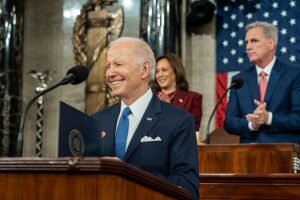China Is Lagging – The Worst Is Yet To Come
Not only is China incapable of preventing a recession — it appears that China’s recession is already underway, and there are several leading indicators suggesting that the worst is yet to come.

Image Credit: Carlos Barria/Reuters
Recently, there has been much debate surrounding whether China can prevent a recession in the upcoming year. In reality, not only is China incapable of preventing a recession — it appears that China’s recession is already underway, and there are several leading indicators suggesting that the worst is yet to come. Despite talks of GDP growth and state-sponsored infrastructure projects to boost its economy, China is currently exhibiting telltale signs of an ongoing recession. The unemployment rates among its young demographic (aged 16-24) increased from 9.6% in 2018 to nearly 20% this year. Thousands of tech workers have been laid off following China’s Big Tech crackdown and cuts made by businesses looking to augment profits (not to mention that these youths will be burdened with caring for China’s aging population. Individuals aged over 65 make up 13% of the population, and this figure is expected to rise significantly in the upcoming years). Further, several real estate developers have defaulted on their offshore bonds, including China’s biggest developer, the Evergrande Group. The high unemployment rates coupled with the country’s largest developer defaulting on its loan signifies that we are already in an economic crisis.
Local governments have bore the brunt of this financial travesty as their reliance on selling land constitutes a significant amount of their income. Many local governments were already struggling with payment obligations resulting from China’s zero-COVID policy, as they are responsible for covering COVID-19-related expenses. As part of the policy, citizens are required to receive COVID tests every few days in order to attend work and use public facilities. Some of China’s biggest testing companies, including Dian Diagnostics and Shanghai Runda Medical Technology, reported that the unpaid debts of local governments total in the billions and continue to rise. Local governments have resorted to selling their assets, idle properties, and mining rights to procure funds. They have also turned to local government financing vehicles (LGFVs) to fill in the void left by private companies. In the past, LGFVs spearheaded infrastructure initiatives by raising money for development projects. Now, China’s LGFVs are making an effort to save the pandemic-stricken economy and cash-strapped local officials by purchasing large quantities of land to support the failing real estate sector. While this strategy will bring short-term relief, the purchased lands remain empty as LGFVs have little experience in property development, and are unsure of how to proceed with construction. This problem, combined with LGFVs borrowing from state banks to finance these endeavors, will likely lead to more economic hardship in the future. Whatever funds local governments receive from the central government do little to stem this crisis as fiscal revenues are split between the two. Consequently, splitting much-needed revenue will provide limited relief and have virtually no impact on the recession at large.
Additionally, while China’s investments in its high-speed railways (HSRs) may appear lucrative, the project will inevitably become another debt trap. Generally, major transportation investments often yield significant capital gains. However, China has already invested in its most lucrative enterprises. The obsession with HSR began in 2009 following the global financial crisis. China restructured its railway industry by creating the first long-distance HSR between Wuhan and Guangzhou. The new train covered 968 kilometers and ran at an average speed of around 350 kilometers per hour. The new project not only improved the quality of transportation—China’s exploration of “Railway Keynesianism” produced high profits as new HSR projects drove up demand for steel and concrete, creating millions of new jobs in the process. In combating the financial devastation caused by COVID-19, China attempted to repeat the profitability of HSR by expanding its railways even further. But such emulation is no longer feasible since earlier projects already reaped the benefits of connecting major metropolises. By 2021, China’s HSRs “covered 40,000 kilometers, connecting 93% of the country’s cities with a population of over 500,000.” Continuous expansion of HSRs into more rural areas will lead China into amassing more unpayable debts (by 2021, China’s railway debt neared $900bn). HSR development costs are three times that of traditional railways; more so, passenger rates declined by 29% from pre-pandemic levels and remain low amid the ongoing pandemic. For instance, only a few dozen passengers use the new Huanggang-Huangmei HSR daily, and the railway failed to attract new businesses or hotels to the area.
Another telltale sign that the recession has hit China is the fact that foreign capital is fleeing its markets at alarming rates due to the country’s diminishing currency value and stumbling economy. The yuan depreciated over 11% on the dollar, and in the first six months of this year, approximately $101 billion was pulled out of China. According to debt market data, $45.2 billion in net outflow was categorized as “errors and omissions,” signifying that capital is leaving the country through illegal or semi-legal vessels. As stated by chief Asia economist Alicia García Herrero from the French bank Natixis: “Errors and omissions basically reflect the exit of residents’ money in an unofficial way…It’s not just foreign asset managers no longer investing in China, it’s the unrecorded outflows that are worsening…People want to bring their money out.” In response to the slowing economy and discouraging data, China’s central bank attempted to revive demand by cutting key lending rates, an atypical strategy as other countries have been raising their interest rates to fight soaring inflation.
The most telling sign of all however was China’s delayed release of its recent economy report. The delay was unprecedented as large economies, wanting to avoid losing confidence in their markets, seldomly postpone the release of their economic data. In this case, China did not provide any reasons for the holdup. Considering that the Communist Party’s (CCP) national congress was previously in session, and one of its talking points included economic improvement under CCP rule, it is likely that President Xi delayed the release of the report until his third term was secured. Per Victor Shih, a specialist in Chinese elite politics and finance at the University of California: “The very likely reason the numbers were delayed was the State Council leaders were afraid the numbers would detract from the triumphant tone of the party congress.” The report was eventually released following the conclusion of the congress and showed that growth remained below its 5.5% target at 3.9%. The figures confirm that “China’s economic risks showed no signs of easing, with strict Covid controls and a property slump continuing to weigh on growth and weaker global demand curbing exports…” The move to conceal China’s weakening economy has been replicated throughout the country, as exporters have been accused of exaggerating their shipment value to customs as a way to smuggle money out of the country, making it more difficult to aggregate data.
Despite China’s attempts to rescue its economy (or, at the very least, to ‘soften the blow’), the issue is beyond taming, and the accrued debts are unpayable. The examples listed herein provide just a glimpse into the situation at large. But the leading indicators are there. As we approach the year 2023, the status and ramifications of China’s economic crisis will become all the more apparent.
Melissa Sukniqi (she/her) is a second-year MA student in NYU’s International Relations department. She received her BA in Jurisprudence from Montclair State University in 2017, where she also minored in Political Science and Sociology. Following graduation, she worked for several years as a paralegal assisting claimants in filing with the 9/11 Victim Compensation Fund Program. Her academic interests primarily concern US Foreign Policy. Outside of school, Melissa enjoys reading, playing video games, and spending time with her Shih Tzu, Tobi.






